Land Subsidence Phenomena vs. Coastal Flood Hazard—The Cases of Messolonghi and Aitolikon (Greece)
Abstract
1. Introduction
2. The Study Area
2.1. Geological Setting
2.2. Geotechnical Setting
2.3. Hydrogeological Setting
3. Sea Level Rise and Annual Precipitation Rates
4. Multi-Temporal InSAR Analysis and PSI Results
4.1. Methodology
4.2. Results
5. In Situ Data
6. Discussion
6.1. Messolonghi Ground Deformations
6.1.1. Deformation Values
6.1.2. Geotechnical Data Correlation
6.1.3. Precipitation Rate Correlation
6.1.4. Underground Water Exploitation
6.1.5. Land Use Correlation
6.1.6. Tectonic Correlation
6.1.7. Similar Case Studies
6.2. Aitolikon Ground Deformations
6.2.1. Deformation Values
6.2.2. Underground Water Exploitation
6.2.3. Geotechnical Data Correlation
7. Conclusions
Supplementary Materials
Author Contributions
Funding
Institutional Review Board Statement
Informed Consent Statement
Data Availability Statement
Acknowledgments
Conflicts of Interest
References
- Solari, L.; Del Soldato, M.; Bianchini, S.; Ciampalini, A.; Ezquerro, P.; Montalti, R.; Raspini, F.; Moretti, S. From ERS 1/2 to Sentinel-1: Subsidence Monitoring in Italy in the Last Two Decades. Front. Earth Sci. 2018, 6, 149. [Google Scholar] [CrossRef]
- Osmanoǧlu, B.; Dixon, T.H.; Wdowinski, S.; Cabral-Cano, E.; Jiang, Y. Mexico City subsidence observed with persistent scatterer InSAR. Int. J. Appl. Earth Obs. Geoinf. 2011, 13, 1–12. [Google Scholar] [CrossRef]
- Cigna, F.; Osmanoǧlu, B.; Cabral-Cano, E.; Dixon, T.H.; Ávila-Olivera, J.A.; Garduño-Monroy, V.H.; DeMets, C.; Wdowinski, S. Monitoring land subsidence and its induced geological hazard with Synthetic Aperture Radar Interferometry: A case study in Morelia, Mexico. Remote Sens. Environ. 2012, 117, 146–161. [Google Scholar] [CrossRef]
- Gambolati, G.; Putti, M.; Teatini, P.; Gasparetto Stori, G. Subsidence due to peat oxidation and impact on drainage infrastructures in a farmland catchment south of the Venice Lagoon. Environ. Geol. 2006, 49, 814–820. [Google Scholar] [CrossRef]
- Hoogland, T.; van den Akker, J.J.H.; Brus, D.J. Modeling the subsidence of peat soils in the Dutch coastal area. Geoderma 2012, 171–172, 92–97. [Google Scholar] [CrossRef]
- Caramanna, G.; Ciotoli, G.; Nisio, S. A review of natural sinkhole phenomena in Italian plain areas. Nat. Hazards 2008, 45, 145–172. [Google Scholar] [CrossRef]
- Galve, J.P.; Gutiérrez, F.; Lucha, P.; Guerrero, J.; Bonachea, J.; Remondo, J.; Cendrero, A. Probabilistic sinkhole modelling for hazard assessment. Earth Surf. Process. Landf. 2009, 34, 437–452. [Google Scholar] [CrossRef]
- Ding, H.; Chen, S.; Chang, S.; Li, G.; Zhou, L. Prediction of Surface Subsidence Extension due to Underground Caving: A Case Study of Hemushan Iron Mine in China. Math. Probl. Eng. 2020, 2020, 5086049. [Google Scholar] [CrossRef]
- Gambolati, G.; Teatini, P. Numerical Analysis of Land Subsidence Due to Natural Compaction of the Upper Adriatic Sea Basin. In CENAS—Coastline Evolution of the Upper Adriatic Sea Due to Sea Level Rise and Natural and Anthropogenic Land Subsidence; Gambolati, G., Ed.; Water Science and Technology Library: Dordrecht, The Netherlands, 1998; Volume 28, pp. 103–131. ISBN 978-94-011-5147-4. [Google Scholar] [CrossRef]
- Kaitantzian, A.; Loupasakis, C.; Tzampoglou, P.; Parcharidis, I. Ground Subsidence Triggered by the Overexploitation of Aquifers Affecting Urban Sites: The Case of Athens Coastal Zone along Faliro Bay (Greece). Geofluids 2020, 2020, 8896907. [Google Scholar] [CrossRef]
- Loupasakis, C.; Rozos, D. Finite-Element Simulation of Land Subsidence Induced by Water Pumping in Kalochori Village, Greece. Q. J. Eng. Geol. Hydrogeol. 2009, 42, 369–382. [Google Scholar] [CrossRef]
- Galloway, D.L.; Burbey, T.J. Review: Regional Land Subsidence Accompanying Groundwater Extraction. Hydrogeol. J. 2011, 19, 1459–1486. [Google Scholar] [CrossRef]
- Pacheco-Martínez, J.; Hernandez-Marín, M.; Burbey, T.J.; González-Cervantes, N.; Ortíz-Lozano, J.Á.; Zermeño-De-Leon, M.E.; Solís-Pinto, A. Land Subsidence and Ground Failure Associated to Groundwater Exploitation in the Aguascalientes Valley, México. Eng. Geol. 2013, 164, 172–186. [Google Scholar] [CrossRef]
- Ezquerro, P.; Guardiola-Albert, C.; Herrera, G.; Fernández-Merodo, J.A.; Béjar-Pizarro, M.; Bonì, R. Groundwater and Subsidence Modeling Combining Geological and Multi-Satellite SAR Data over the Alto Guadalentín Aquifer (SE Spain). Geofluids 2017, 2017, 1359325. [Google Scholar] [CrossRef]
- Tzampoglou, P.; Loupasakis, C. Numerical Simulation of the Factors Causing Land Subsidence Due to Overexploitation of the Aquifer in the Amyntaio Open Coal Mine, Greece. HydroResearch 2019, 1, 8–24. [Google Scholar] [CrossRef]
- Buffardi, C.; Barbato, R.; Vigliotti, M.; Mandolini, A.; Ruberti, D. The Holocene Evolution of the Volturno Coastal Plain (Northern Campania, Southern Italy): Implications for the Understanding of Subsidence Patterns. Water 2021, 13, 2692. [Google Scholar] [CrossRef]
- Bruno, L.; Campo, B.; Costagli, B.; Stouthamer, E.; Teatini, P.; Zoccarato, C.; Amorosi, A. Factors controlling natural subsidence in the Po Plain. Proc. Int. Assoc. Hydrol. Sci. 2020, 382, 285–290. [Google Scholar] [CrossRef]
- Teatini, P.; Tosi, L.; Strozzi, T. Quantitative evidence that compaction of Holocene sediments drives the present land subsidence of the Po Delta. J. Geophys. Res. 2011, 116, B08407. [Google Scholar] [CrossRef]
- Meckel, T.A.; Brink, U.S.; Williams, S.J. Current subsidence rates due to compaction of Holocene sediments in southern Louisiana. Geophys. Res. Lett. 2006, 33, L11403. [Google Scholar] [CrossRef]
- Tornqvist, T.E.; Wallace, D.J.; Storms, J.E.A.; Wallinga, J.; Van Dam, R.L.; Blaauw, M.; Derksen, M.S.; Klerks, C.J.W.; Meijneken, C.; Snijders, E.M.A. Mississippi Delta subsidence primarily caused by compaction of Holocene strata. Nat. Geosci. 2008, 1, 173–176. [Google Scholar] [CrossRef]
- van Asselen, S.; Stouthamer, E.; van Asch, T.W.J. Effects of peat compaction on delta evolution: A review on processes, responses, measuring and modeling. Earth-Sci. Rev. 2009, 92, 35–51. [Google Scholar] [CrossRef]
- Tosi, L.; Da Lio, C.; Donnici, S.; Strozzi, T.; Teatini, P. Vulnerability of Venice’s Coastland to Relative Sea-Level Rise. Proc. Int. Assoc. Hydrol. Sci. 2020, 382, 689–695. [Google Scholar] [CrossRef]
- Johnston, J.; Cassalho, F.; Miesse, T.; Ferreira, C.M. Projecting the Effects of Land Subsidence and Sea Level Rise on Storm Surge Flooding in Coastal North Carolina. Sci. Rep. 2021, 11, 21679. [Google Scholar] [CrossRef] [PubMed]
- Nicholls, R.J.; Lincke, D.; Hinkel, J.; Brown, S.; Vafeidis, A.T.; Meyssignac, B.; Hanson, S.E.; Merkens, J.-L.; Fang, J. A Global Analysis of Subsidence, Relative Sea-Level Change and Coastal Flood Exposure. Nat. Clim. Chang. 2021, 11, 338–342. [Google Scholar] [CrossRef]
- Solari, L.; Ciampalini, A.; Raspini, F.; Bianchini, S.; Moretti, S. PSInSAR Analysis in the Pisa Urban Area (Italy): A Case Study of Subsidence Related to Stratigraphical Factors and Urbanization. Remote Sens. 2016, 8, 120. [Google Scholar] [CrossRef]
- Da Lio, C.; Tosi, L. Land Subsidence in the Friuli Venezia Giulia Coastal Plain, Italy: 1992–2010 Results from SAR-Based Interferometry. Sci. Total Environ. 2018, 633, 752–764. [Google Scholar] [CrossRef] [PubMed]
- Ciampalini, A.; Solari, L.; Giannecchini, R.; Galanti, Y.; Moretti, S. Evaluation of Subsidence Induced by Long-Lasting Buildings Load Using InSAR Technique and Geotechnical Data: The Case Study of a Freight Terminal (Tuscany, Italy). Int. J. Appl. Earth Obs. Geoinf. 2019, 82, 101925. [Google Scholar] [CrossRef]
- Yastika, P.E.; Shimizu, N.; Abidin, H.Z. Monitoring of Long-Term Land Subsidence from 2003 to 2017 in Coastal Area of Semarang, Indonesia by SBAS DInSAR Analyses Using Envisat-ASAR, ALOS-PALSAR, and Sentinel-1A SAR Data. Adv. Space Res. 2019, 63, 1719–1736. [Google Scholar] [CrossRef]
- Papadopoulos, G.A.; Ganas, A.; Agalos, A.; Papageorgiou, A.; Triantafyllou, I.; Kontoes, C.; Papoutsis, I.; Diakogianni, G. Earthquake Triggering Inferred from Rupture Histories, DInSAR Ground Deformation and Stress-Transfer Modelling: The Case of Central Italy During August 2016–January 2017. Pure Appl. Geophys. 2017, 174, 3689–3711. [Google Scholar] [CrossRef]
- Herrera-García, G.; Ezquerro, P.; Tomás, R.; Béjar-Pizarro, M.; López-Vinielles, J.; Rossi, M.; Mateos, R.M.; Carreón-Freyre, D.; Lambert, J.; Teatini, P.; et al. Mapping the Global Threat of Land Subsidence. Science 2021, 371, 34–36. [Google Scholar] [CrossRef]
- Amato, V.; Aucelli, P.P.C.; Corrado, G.; Di Paola, G.; Matano, F.; Pappone, G.; Schiattarella, M. Comparing Geological and Persistent Scatterer Interferometry Data of the Sele River Coastal Plain, Southern Italy: Implications for Recent Subsidence Trends. Geomorphology 2020, 351, 106953. [Google Scholar] [CrossRef]
- Sykioti, O.; Kontoes, C.C.; Elias, P.; Briole, P.; Sachpazi, M.; Paradissis, D.; Kotsis, I. Ground deformation at Nisyros volcano (Greece) detected by ERS-2 SAR differential interferometry. Int. J. Remote Sens. 2003, 24, 183–188. [Google Scholar] [CrossRef]
- Parcharidis, I.; Kourkouli, P.; Karymbalis, E.; Foumelis, M.; Karathanassi, V. Time series synthetic aperture radar interferometry for ground deformation monitoring over a small scale tectonically active deltaic environment (Mornos, Central Greece). J. Coast. Res. 2013, 29, 325–338. [Google Scholar] [CrossRef]
- Kontoes, C.; Loupasakis, C.; Papoutsis, I.; Alatza, S.; Poyiadji, E.; Ganas, A.; Psychogyiou, C.; Kaskara, M.; Antoniadi, S.; Spanou, N. Landslide Susceptibility Mapping of Central and Western Greece, Combining NGI and WoE Methods, with Remote Sensing and Ground Truth Data. Land 2021, 10, 402. [Google Scholar] [CrossRef]
- Alatza, S.; Papoutsis, I.; Paradissis, D.; Kontoes, C.; Papadopoulos, G.A.; Raptakis, C. InSAR Time-Series Analysis for Monitoring Ground Displacement Trends in the Western Hellenic Arc: The Kythira Island, Greece. Geosciences 2020, 10, 293. [Google Scholar] [CrossRef]
- Papoutsis, I.; Kontoes, C.; Paradissis, D. Multi-Stack Persistent Scatterer Interferometry Analysis in Wider Athens, Greece. Remote Sens. 2017, 9, 276. [Google Scholar] [CrossRef]
- Kontoes, C.; Alatza, S.; Chousianitis, K.; Svigkas, N.; Loupasakis, C.; Atzori, S.; Apostolakis, A. Coseismic Surface Deformation, Fault Modeling, and Coulomb Stress Changes of the March 2021 Thessaly, Greece, Earthquake Sequence Based on InSAR and GPS Data. Seismol. Res. Lett. 2022, 93, 2584–2598. [Google Scholar] [CrossRef]
- Alatza, S.; Papoutsis, I.; Paradissis, D.; Kontoes, C.; Papadopoulos, G.A. Multi-Temporal InSAR Analysis for Monitoring Ground Deformation in Amorgos Island, Greece. Sensors 2020, 20, 338. [Google Scholar] [CrossRef]
- Ilia, I.; Loupasakis, C.; Tsangaratos, P. Land Subsidence Phenomena Investigated by Spatiotemporal Analysis of Groundwater Resources, Remote Sensing Techniques, and Random Forest Method: The Case of Western Thessaly, Greece. Environ. Monit. Assess. 2018, 190, 623. [Google Scholar] [CrossRef] [PubMed]
- Tsangaratos, P.; Loupasakis, C.; Ilia, I. Ground Subsidence Phenomena in Frakadona, West Thessaly, Greece. In Proceedings of the Fifth International Conference on Remote Sensing and Geoinformation of the Environment (RSCy2017), Paphos, Cyprus, 6 September 2017; Volume 10444, pp. 149–157. [Google Scholar] [CrossRef]
- Rozos, D.; Sideri, D.; Loupasakis, C.; Apostolidis, E. Land Subsidence Due to Excessive Ground Water Withdrawal. A Case Study from Stavros—Farsala Site, West Thessaly Greece. Bull. Geol. Soc. Greece 2010, 43, 1850–1857. [Google Scholar] [CrossRef]
- Raspini, F.; Loupasakis, C.; Rozos, D.; Adam, N.; Moretti, S. Ground Subsidence Phenomena in the Delta Municipality Region (Northern Greece): Geotechnical Modeling and Validation with Persistent Scatterer Interferometry. Int. J. Appl. Earth Obs. Geoinf. 2014, 28, 78–89. [Google Scholar] [CrossRef]
- Svigkas, N.; Papoutsis, I.; Constantinos, L.; Tsangaratos, P.; Kiratzi, A.; Kontoes, C.H. Land Subsidence Rebound Detected via Multi-Temporal InSAR and Ground Truth Data in Kalochori and Sindos Regions, Northern Greece. Eng. Geol. 2016, 209, 175–186. [Google Scholar] [CrossRef]
- Svigkas, N.; Papoutsis, I.; Loupasakis, C.; Tsangaratos, P.; Kiratzi, A.; Kontoes, C.H. InSAR Time-Series Monitoring of Ground Displacement Trends in an Industrial Area (Oreokastro—Thessaloniki, Greece): Detection of Natural Surface Rebound and New Tectonic Insights. Environ. Earth Sci. 2017, 76, 195. [Google Scholar] [CrossRef]
- Loupasakis, C.; Rozos, D. Land Subsidence Induced by the Overexploitation of the Aquifers in Kalochori Village—New Approach by Means of the Computational Geotechnical Engineering. Bull. Geol. Soc. Greece 2010, 43, 1219–1229. [Google Scholar] [CrossRef]
- Svigkas, N.; Loupasakis, C.; Papoutsis, I.; Kontoes, C.; Alatza, S.; Tzampoglou, P.; Tolomei, C.; Spachos, T. InSAR Campaign Reveals Ongoing Displacement Trends at High Impact Sites of Thessaloniki and Chalkidiki, Greece. Remote Sens. 2020, 12, 2396. [Google Scholar] [CrossRef]
- Raspini, F.; Loupasakis, C.; Rozos, D.; Moretti, S. Advanced Interpretation of Land Subsidence by Validating Multi-Interferometric SAR Data: The Case Study of the Anthemountas Basin (Northern Greece). Nat. Hazards Earth Syst. Sci. 2013, 13, 2425–2440. [Google Scholar] [CrossRef]
- Raspini, F.; Bianchini, S.; Moretti, S.; Loupasakis, C.; Rozos, D.; Duro, J.; Garcia, M. Advanced Interpretation of Interferometric SAR Data to Detect, Monitor and Model Ground Subsidence: Outcomes from the ESA-GMES Terrafirma Project. Nat. Hazards 2016, 83, 155–181. [Google Scholar] [CrossRef]
- Svigkas, N.; Loupasakis, C.; Tsangaratos, P.; Papoutsis, I.; Kiratzi, A.; Kontoes, C. A Deformation Study of Anthemountas Graben (Northern Greece) Based on in Situ Data and New InSAR Results. Arab. J. Geosci. 2020, 13, 518. [Google Scholar] [CrossRef]
- Svigkas, N.; Papoutsis, I.; Loupasakis, C.; Tsangaratos, P.; Kiratzi, A.; Kontoes, C. Radar Space Measurements of the Deforming Trends at Northern Greece Resulting from Underground Water Activity. In BT—Advances in Remote Sensing and Geo Informatics Applications; El-Askary, H.M., Lee, S., Heggy, E., Pradhan, B., Eds.; Springer International Publishing: Cham, Switzerland, 2019; pp. 309–313. [Google Scholar] [CrossRef]
- Raspini, F.; Loupasakis, C.; Rozos, D.; Moretti, S. Basin and Local Scale Detection of Ground Subsidence through Persistent Scatterer Interferometry: The Anthemountas Basin (Northern Greece) Case Study. Bull. Geol. Soc. Greece 2013, 47, 1510–1518. [Google Scholar] [CrossRef]
- Papoutsis, I.; Kontoes, C.; Alatza, S.; Apostolakis, A.; Loupasakis, C. InSAR Greece with Parallelized Persistent Scatterer Interferometry: A National Ground Motion Service for Big Copernicus Sentinel-1 Data. Remote Sens. 2020, 12, 3207. [Google Scholar] [CrossRef]
- Lemesios, I. Environmental Hydrogeological Survey of the Horizons of the Wider Area of the Municipality of Messolonghi in Relation to Its Natural Healing Resources. Master’s Thesis, University of Patras, Patras, Greece, 2008. Available online: https://hdl.handle.net/10889/823 (accessed on 21 December 2022).
- Hellenic Survey of Geology & Mineral Exploration (HSGME). Geotechnical Investigation of the Foundations for the Construction of Worker’s Households in the Areas of Messolonghi-Aitolikon I, II-Agrinio; Technical Report; HSGME: Acharnes, Greece, 1987; p. 5244. [Google Scholar]
- Hellenic Survey of Geology & Mineral Exploration (HSGME). Geological Report on the Messolonghi Lagoon Drainage Projects; Technical Report; HSGME: Acharnes, Greece, 1958; p. 564. [Google Scholar]
- Central Laboratory of Public Works. Messolonghi V—O.E.K.; Technical Report; Ministry of the Environment, Urban Planning and Public Works: Athens, Greece, 1997; pp. 8.5–118.
- Central Laboratory of Public Works. Geotechnical Investigation in O.E.K. Site for the Construction of Worker’s Households in Messolonghi (Messolonghi V); Technical Report; Ministry of the Environment, Urban Planning and Public Works: Athens, Greece, 1997; pp. 8.5–133.
- Douveas, N.; Kavadia, D.; Papadopoulou, P. Geotechnical Foundation Conditions of Mesologion Swimming Pool Center. Bull. Geol. Soc. Greece 2007, 40, 1644–1651. [Google Scholar] [CrossRef]
- Vignudelli, S.; Birol, F.; Benveniste, J.; Fu, L.L.; Picot, N.; Raynal, M.; Roinard, H. Satellite Altimetry Measurements of Sea Level in the Coastal Zone. Surv. Geophys. 2019, 40, 1319–1349. [Google Scholar] [CrossRef]
- The Climate Change Initiative Coastal Sea Level Team. Coastal Sea Level Anomalies and Associated Trends from Jason Satellite Altimetry over 2002–2018. Sci. Data 2020, 7, 357. [Google Scholar] [CrossRef] [PubMed]
- Legeais, J.F.; Meyssignac, B.; Faugère, Y.; Guerou, A.; Ablain, M.; Pujol, M.I.; Dufau, C.; Dibarboure, G. Copernicus Sea Level Space Observations: A Basis for Assessing Mitigation and Developing Adaptation Strategies to Sea Level Rise. Front. Mar. Sci. 2021, 8, 1668. [Google Scholar] [CrossRef]
- Frederikse, T.; Landerer, F.; Caron, L.; Adhikari, S.; Parkes, D.; Humphrey, V.W.; Dangendorf, S.; Hogarth, P.; Zanna, L.; Cheng, L.; et al. The Causes of Sea-Level Rise since 1900. Nature 2020, 584, 393–397. [Google Scholar] [CrossRef]
- Hamlington, B.D.; Frederikse, T.; Nerem, R.S.; Fasullo, J.T.; Adhikari, S. Investigating the Acceleration of Regional Sea Level Rise During the Satellite Altimeter Era. Geophys. Res. Lett. 2020, 47, e2019GL086528. [Google Scholar] [CrossRef]
- Fasullo, J.T.; Nerem, R.S. Altimeter-Era Emergence of the Patterns of Forced Sea-Level Rise in Climate Models and Implications for the Future. Proc. Natl. Acad. Sci. USA 2018, 115, 12944–12949. [Google Scholar] [CrossRef]
- Nerem, R.S.; Beckley, B.D.; Fasullo, J.T.; Hamlington, B.D.; Masters, D.; Mitchum, G.T. Climate-Change–Driven Accelerated Sea-Level Rise Detected in the Altimeter Era. Proc. Natl. Acad. Sci. USA 2018, 115, 2022–2025. [Google Scholar] [CrossRef]
- Marcos, M.; Jorda, G.; Cozannet, G. Le Sub-Chapter 2.2.1. Sea Level Rise and Its Impacts on the Mediterranean. In The Mediterranean Region under Climate Change: A Scientific Update; IRD Éditions: Marseille, France, 2016; pp. 265–275. ISBN 9782709922203. [Google Scholar] [CrossRef]
- Copernicus Climate Change Service. Sea Level|Copernicus. Available online: https://climate.copernicus.eu/climate-indicators/sea-level (accessed on 25 September 2022).
- NOAA/NESDIS/STAR—Laboratory for Satellite Altimetry/Sea Level Rise. Sea Level Rise. Available online: https://www.star.nesdis.noaa.gov/socd/lsa/SeaLevelRise/LSA_SLR_timeseries.php (accessed on 25 September 2022).
- European Environment Agency. Global and European Sea Level Rise. Available online: https://www.eea.europa.eu/ims/global-and-european-sea-level-rise (accessed on 25 September 2022).
- Flanders Marine Institute (VLIZ). Intergovernmental Oceanographic Commission (IOC) (2022): Sea Level Station Monitoring Facility at VLIZ. Available online: https://www.ioc-sealevelmonitoring.org (accessed on 25 September 2022). [CrossRef]
- Climate Change Knowledge Portal Greece. Sea Level Rise. Available online: https://climateknowledgeportal.worldbank.org/country/greece/impacts-sea-level-rise (accessed on 25 September 2022).
- NASA. Sea Level Projection Tool—NASA Sea Level Change Portal. Available online: https://sealevel.nasa.gov/ipcc-ar6-sea-level-projection-tool (accessed on 27 September 2022).
- FloodMap. Available online: https://www.floodmap.net (accessed on 10 October 2022).
- Pavlopoulos, K. Greek Case Studies: The Implications of the Expected Sea Level Rise on the Low Lying Areas of Continental Greece in the Next Century. 2020. Available online: http://www.coastalwiki.org/wiki/Greek_case_studies:_The_implications_of_the_expected_sea_level_rise_on_the_low_lying_areas_of_continental_Greece_in_the_next_century (accessed on 10 January 2023).
- Lagouvardos, K.; Kotroni, V.; Bezes, A.; Koletsis, I.; Kopania, T.; Lykoudis, S.; Mazarakis, N.; Papagiannaki, K.; Vougioukas, S. The Automatic Weather Stations NOANN Network of the National Observatory of Athens: Operation and Database. Geosci. Data J. 2017, 4, 4–16. [Google Scholar] [CrossRef]
- Messolonghibylocals.com. Available online: https://messolonghibylocals.com/floodmessolonghi (accessed on 28 November 2022).
- Agrinioculture.gr. Available online: https://www.agrinioculture.gr/2014/10/06/provlimata-apo-tin-kakokeria-stin-etoloakarnania (accessed on 28 November 2022).
- AgrinioNews.gr. Available online: https://www.agrinionews.gr/aganaktisan-aitoliko-vrochi-kai-plimmyra (accessed on 28 November 2022).
- Hooper, A.; Segall, P.; Zebker, H. Persistent Scatterer Interferometric Synthetic Aperture Radar for Crustal Deformation Analysis, with Application to Volcán Alcedo, Galápagos. J. Geophys. Res. 2007, 112, B07407. [Google Scholar] [CrossRef]
- Hellenic Mirror Site and the Sentinel Greek Copernicus Data Hubs. Available online: https://sentinels.space.noa.gr (accessed on 5 December 2022).
- Bekaert, D.P.S.; Walters, R.J.; Wright, T.J.; Hooper, A.J.; Parker, D.J. Statistical Comparison of InSAR Tropospheric Correction Techniques. Remote Sens. Environ. 2015, 170, 40–47. [Google Scholar] [CrossRef]
- Gkartzou, E.; Parcharidis, I.; Karymbalis, E.; Drakatou, M.L. Multitemporal SAR Interferometry in the Messolonghi-Etoliko Natura 2000 Overlapping Deltas Area. In Proceedings of the Fringe 2015: Advances in the Science and Applications of SAR Interferometry and Sentinel-1 InSAR Workshop, Frascati, Italy, 23–27 March 2015; Ouwehand, L., Ed.; ESA Publication SP-731: Frascati, Italy. [Google Scholar] [CrossRef]
- Crosetto, M.; Solari, L.; Mróz, M.; Balasis-Levinsen, J.; Casagli, N.; Frei, M.; Oyen, A.; Moldestad, D.A.; Bateson, L.; Guerrieri, L.; et al. The Evolution of Wide-Area DInSAR: From Regional and National Services to the European Ground Motion Service. Remote Sens. 2020, 12, 2043. [Google Scholar] [CrossRef]
- Costantini, M.; Minati, F.; Trillo, F.; Ferretti, A.; Novali, F.; Passera, E.; Dehls, J.; Larsen, Y.; Marinkovic, P.; Eineder, M.; et al. European Ground Motion Service (EGMS). In Proceedings of the International Symposium on Geoscience and Remote Sensing (IGARSS), Brussels, Belgium, 11–16 July 2021; pp. 3293–3296. [Google Scholar] [CrossRef]
- EGMS White Paper. Available online: https://land.copernicus.eu/user-corner/technical-library/egms-white-paper (accessed on 25 February 2022).
- CLSM. Available online: https://www.copernicus.eu/en/copernicus-services/land (accessed on 25 February 2022).
- Groundwater Monitoring Network—DIPYN of HSGME. Available online: https://gaia.igme.gr/portal/apps/webappviewer/index.html?id=ba3251562a9f48dab498b8de2637afd3 (accessed on 28 November 2022).
- © European Union. Copernicus Land Monitoring Service 2006; European Environment Agency (EEA): Copenhagen, Denmark, 2006.
- © European Union. Copernicus Land Monitoring Service 2018; European Environment Agency (EEA): Copenhagen, Denmark, 2018.




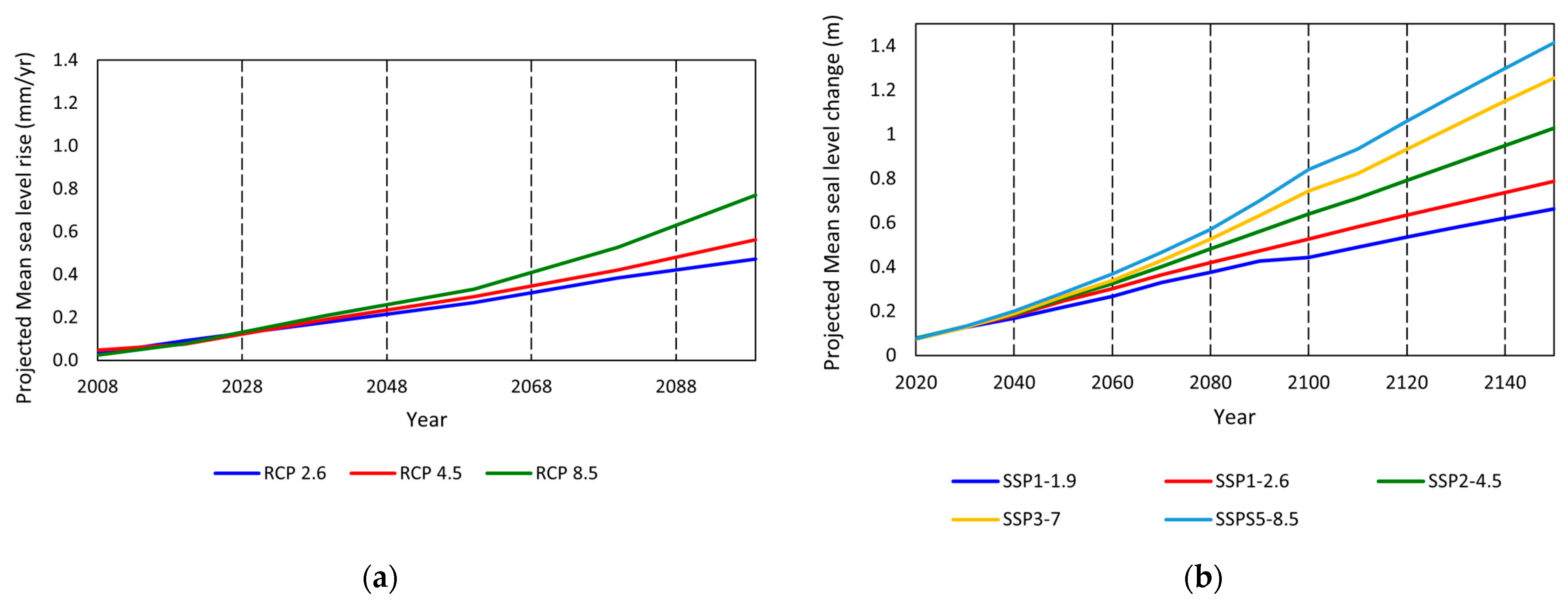


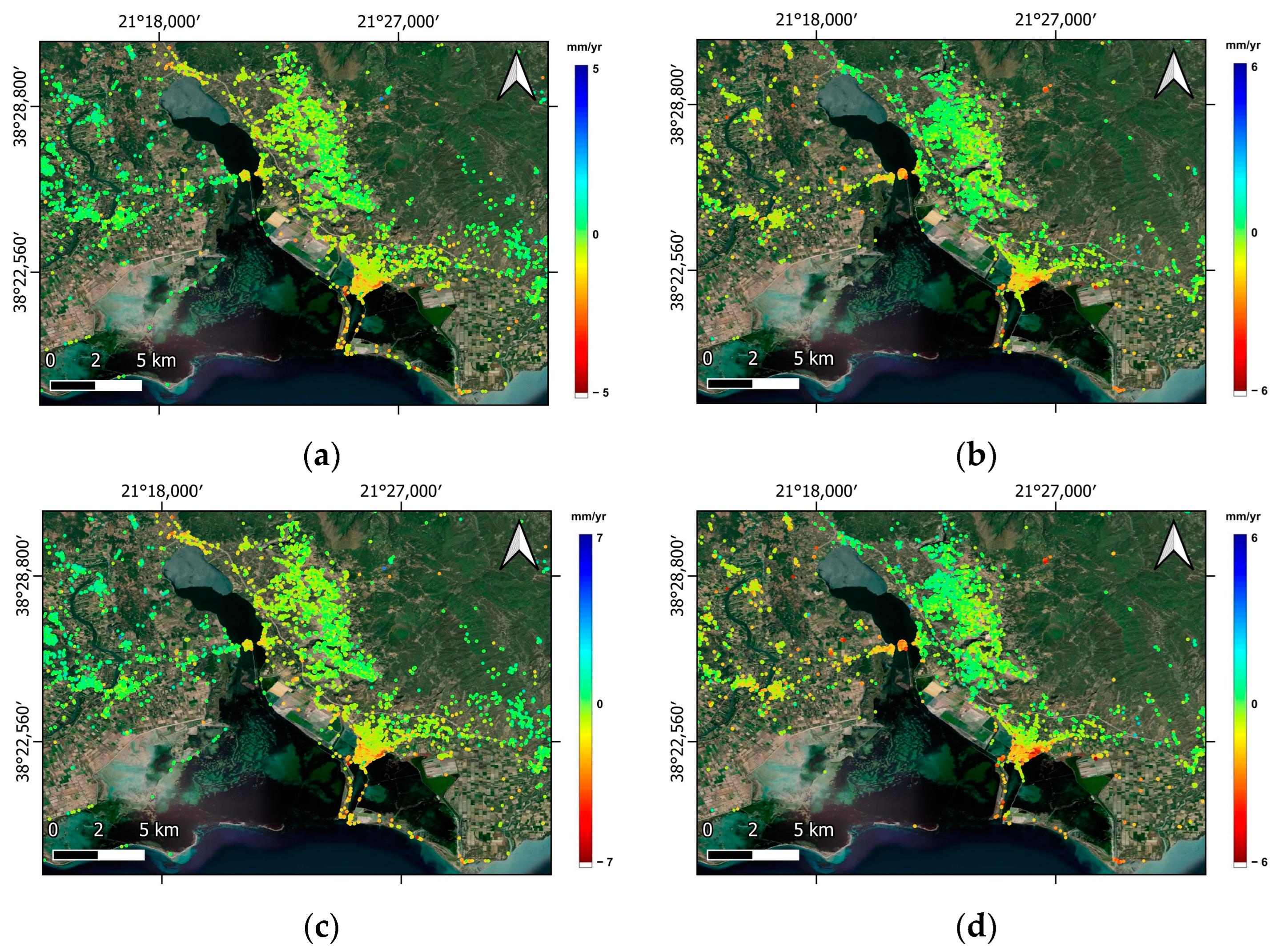
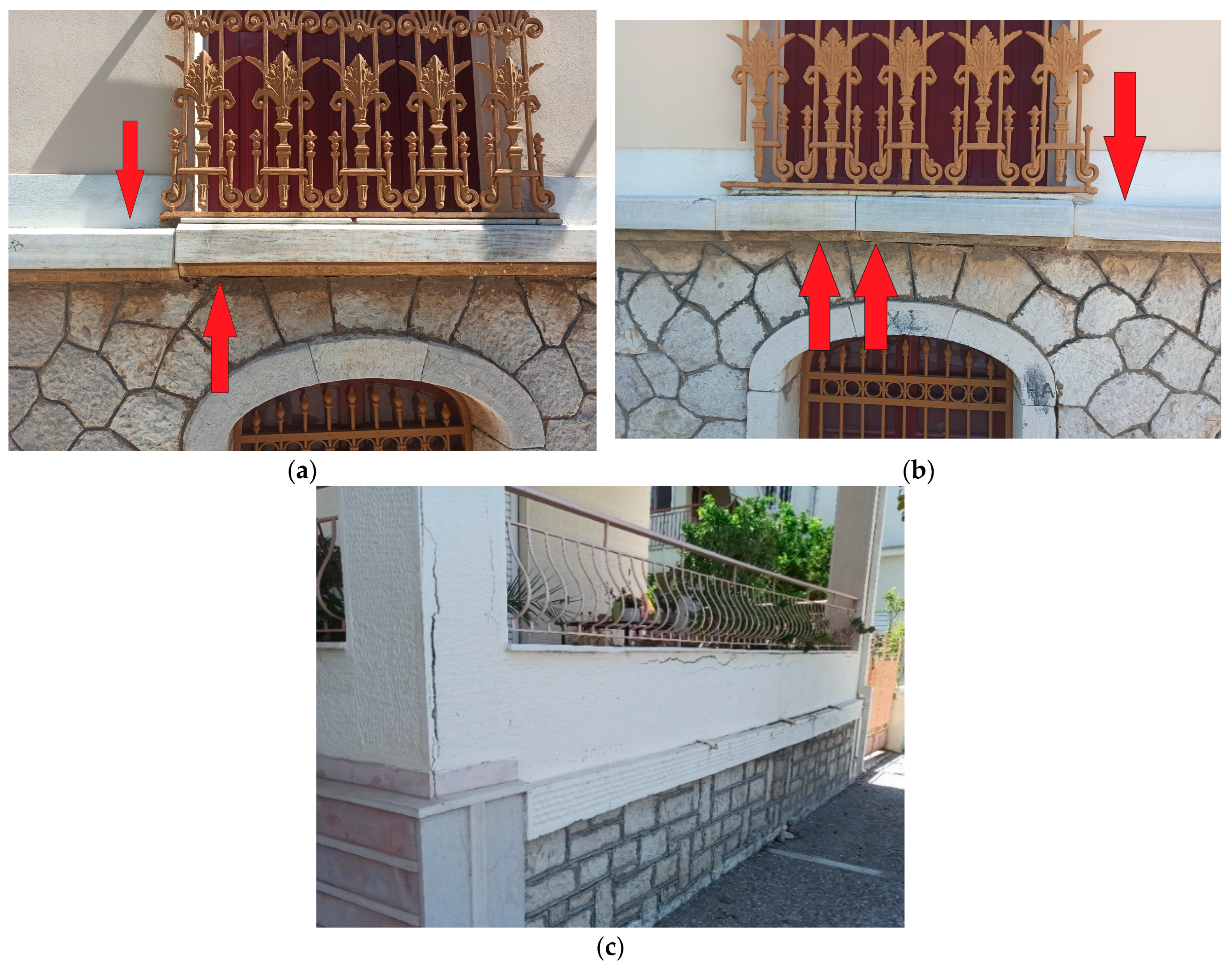
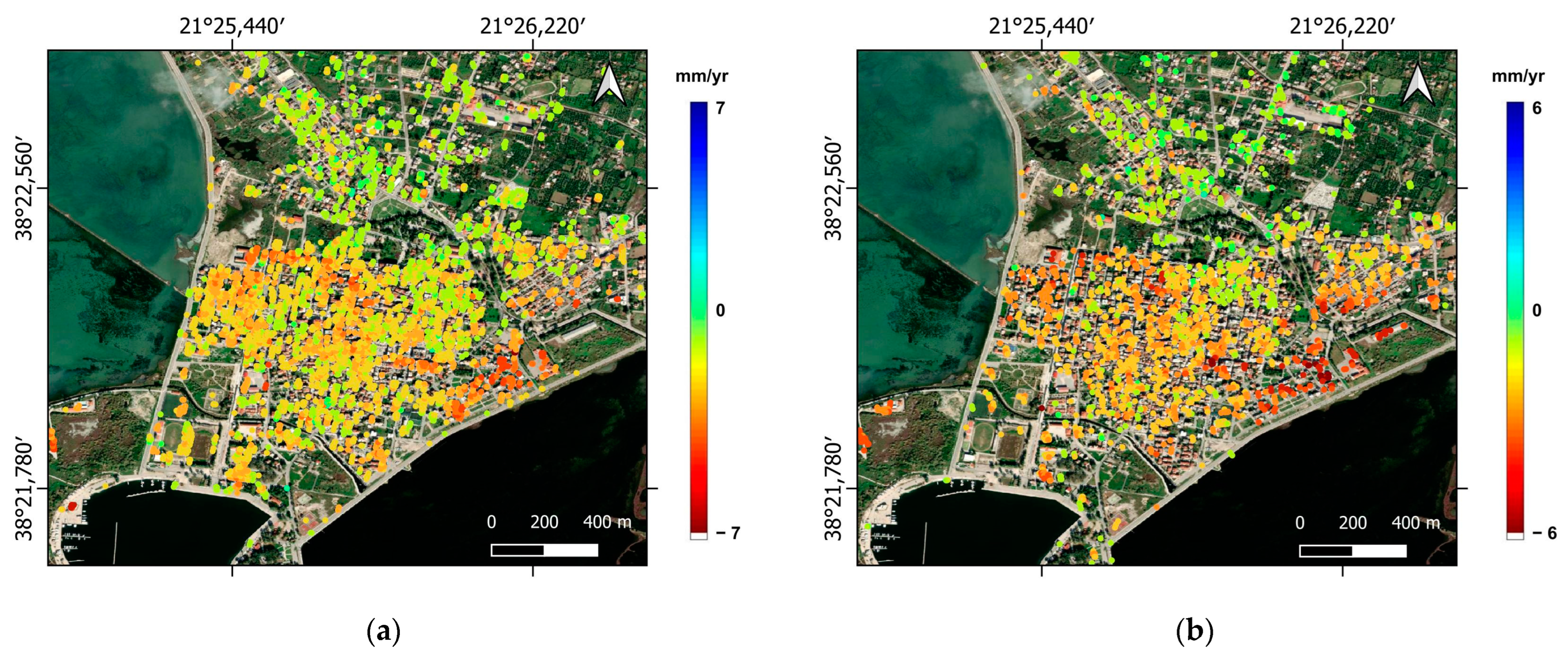
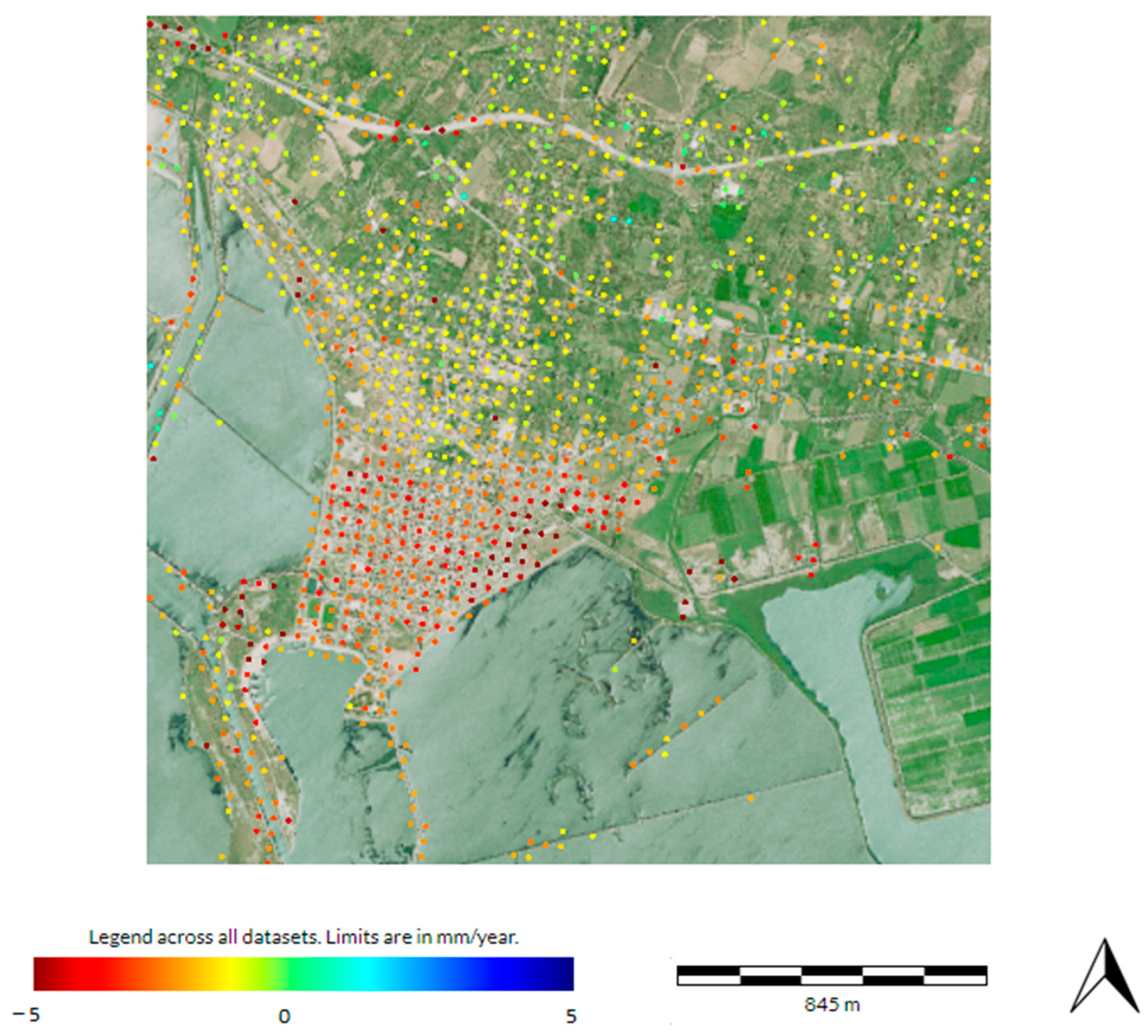


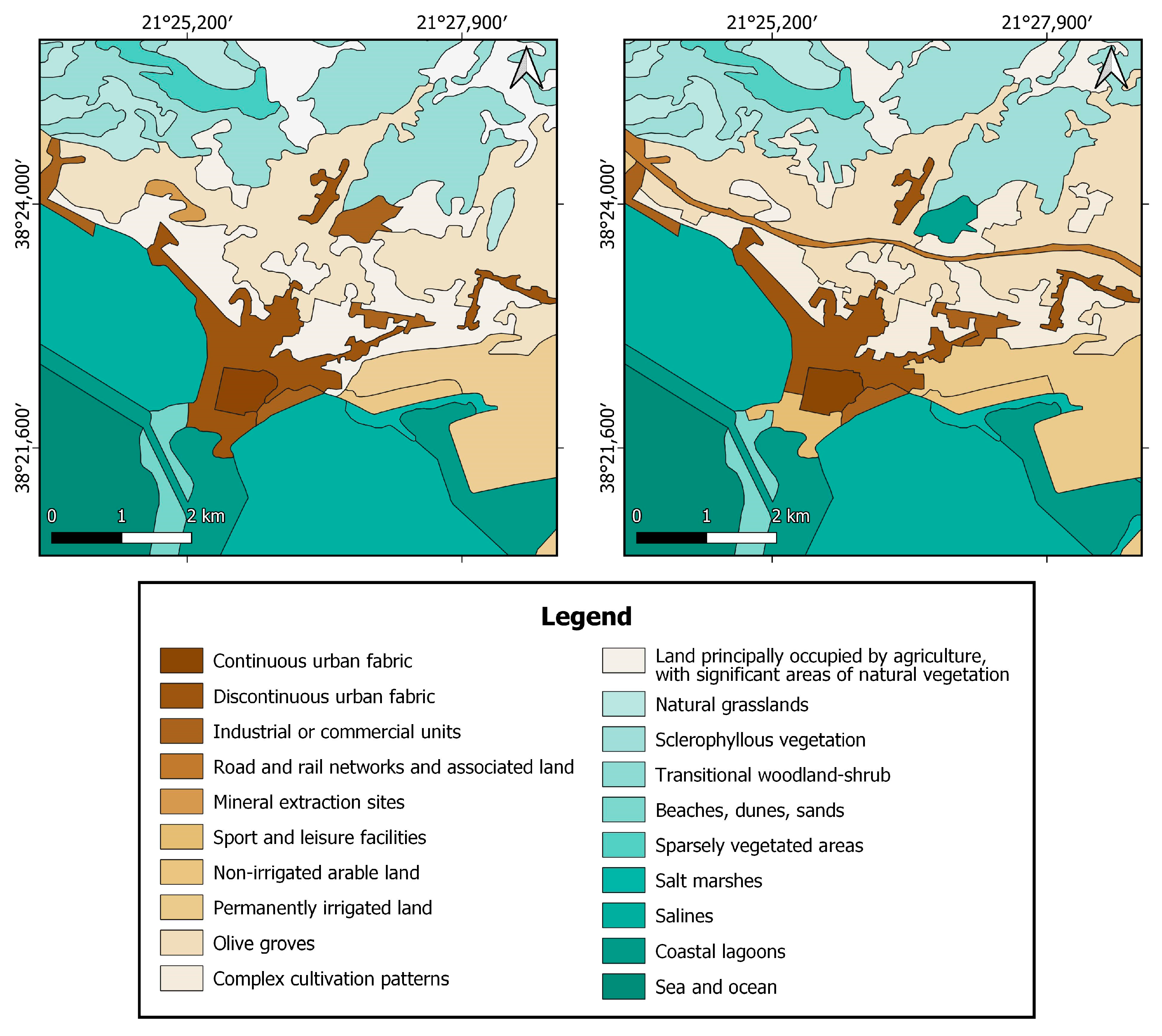
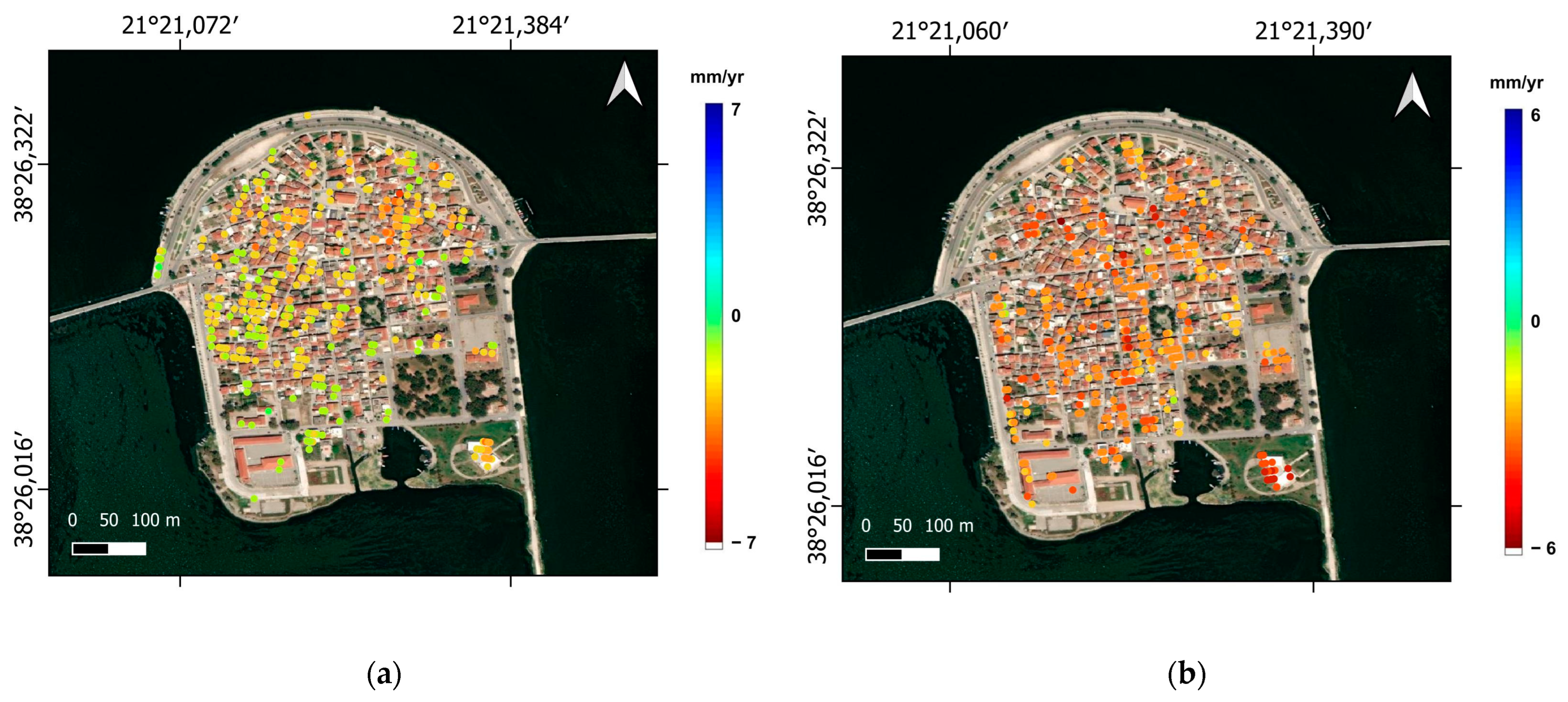

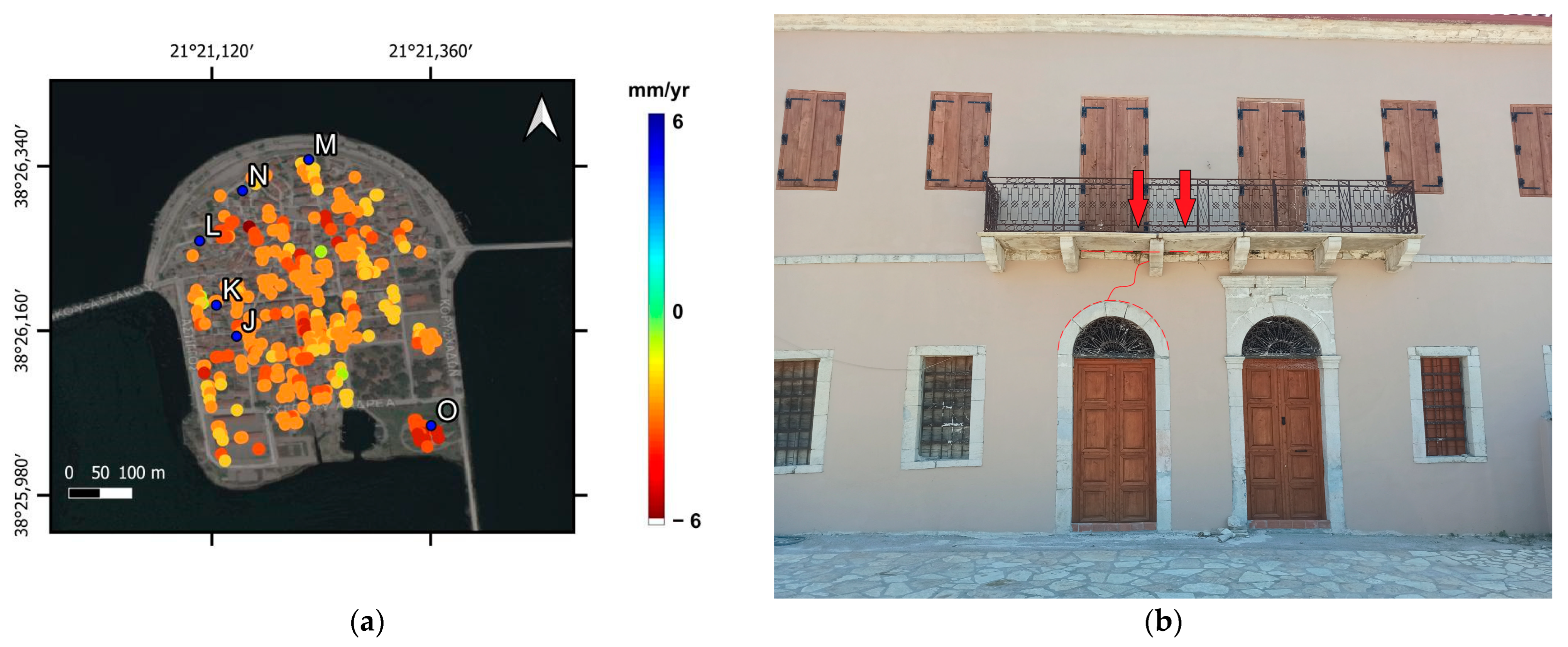
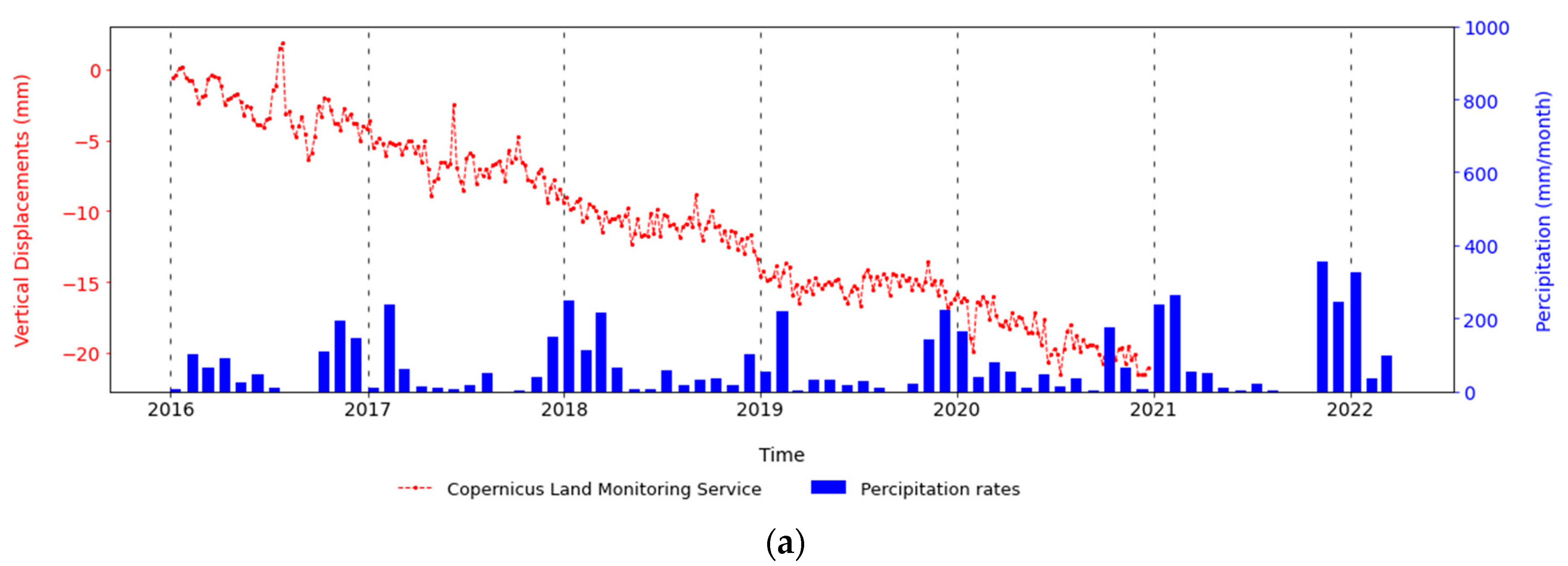
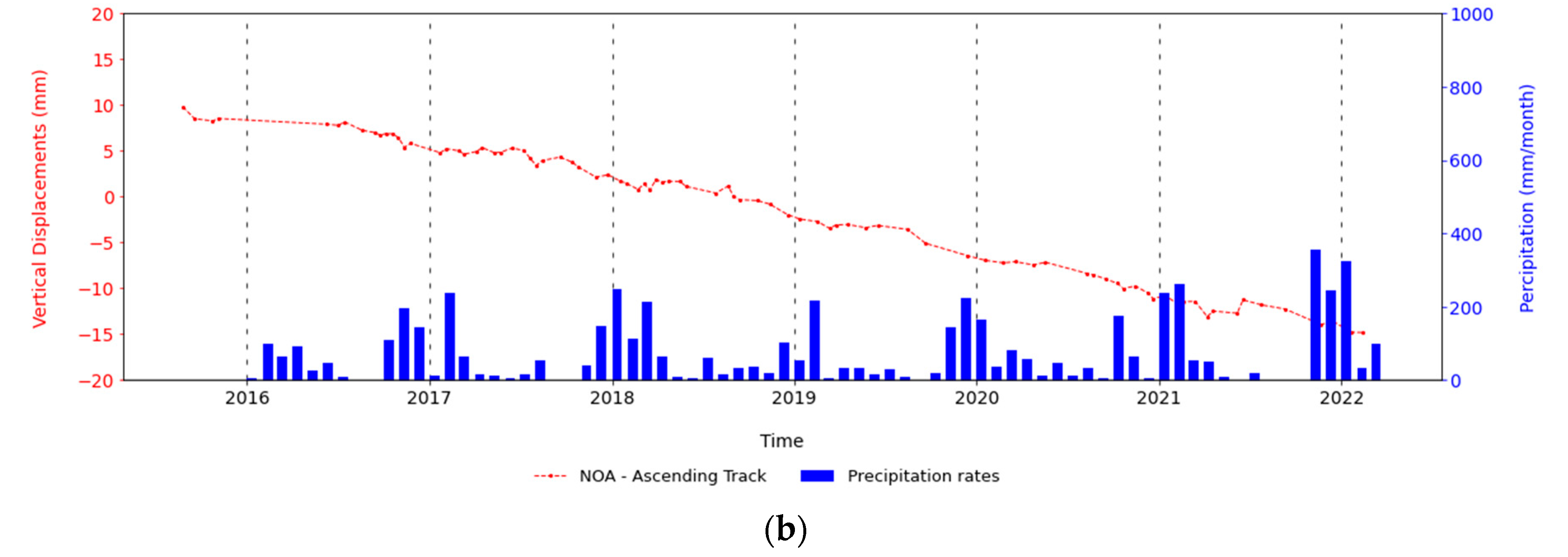
| Clayey Silt | Organic Clay | Clayey Sand | |||||||
|---|---|---|---|---|---|---|---|---|---|
| Unified Soil Classification System (USCS) Classification | |||||||||
| SL | CL | ML | |||||||
| Min | Average | Max | Min | Average | Max | Min | Average | Max | |
| Physical Parameters | |||||||||
| Liquid Limit, LL (%) | 29 | 33.1 | 38.1 | 24.9 | 36.01 | 49.7 | - | - | - |
| Plasticity Limit, PL (%) | 18 | 19.8 | 21 | 12 | 18.94 | 27.7 | - | - | - |
| Sat. unit weight, γ (kN/m3) | 17.4 | 19.2 | 21.6 | 18.5 | 19.5 | 20.3 | - | 20.3 | - |
| Mechanical Parameters | |||||||||
| Initial void ration, e | 0.69 | 0.86 | 1.07 | 0.56 | 0.8 | 1 | - | 0.86 | - |
| Compression index, Cc | 0.222 | 0.276 | 0.3 | 0.23 | 0.282 | 0.328 | - | - | - |
| UC Strength, qu (kPa) | - | - | - | - | 61.9 | - | - | - | - |
| Shear Box Test | |||||||||
| Cohesion, c (kN/m2) | 1.89 | 7.82 | 17.76 | 8.54 | 20.9 | 33.3 | - | 39.08 | - |
| Friction angle, φ | 3.7 | 13 | 22.1 | 19.1 | 21.6 | 24.1 | - | 40 | - |
| Standard Penetration Test | |||||||||
| NSPT | 7 | 7 | 8 | 3 | 8 | 18 | - | 13 | - |
| Min | Average | Max | |
|---|---|---|---|
| Depth | 5 | 27.2 | 100 |
| Sensor | Satellite Pass | Path-Frame | No. of Images | No. of Permanent Scatterers | Temporal Coverage | Primary Image |
|---|---|---|---|---|---|---|
| Sentinel 1A/1B | Descending | 80–463 | 163 | 160,819 | 11 November 2015– 21 December 2021 | 12 April 2019 |
| Ascending | 175–119 | 120 | 49,378 | 13 August 2015– 13 February 2022 | 22 June 2018 |
Disclaimer/Publisher’s Note: The statements, opinions and data contained in all publications are solely those of the individual author(s) and contributor(s) and not of MDPI and/or the editor(s). MDPI and/or the editor(s) disclaim responsibility for any injury to people or property resulting from any ideas, methods, instructions or products referred to in the content. |
© 2023 by the authors. Licensee MDPI, Basel, Switzerland. This article is an open access article distributed under the terms and conditions of the Creative Commons Attribution (CC BY) license (https://creativecommons.org/licenses/by/4.0/).
Share and Cite
Antoniadis, N.; Alatza, S.; Loupasakis, C.; Kontoes, C. Land Subsidence Phenomena vs. Coastal Flood Hazard—The Cases of Messolonghi and Aitolikon (Greece). Remote Sens. 2023, 15, 2112. https://doi.org/10.3390/rs15082112
Antoniadis N, Alatza S, Loupasakis C, Kontoes C. Land Subsidence Phenomena vs. Coastal Flood Hazard—The Cases of Messolonghi and Aitolikon (Greece). Remote Sensing. 2023; 15(8):2112. https://doi.org/10.3390/rs15082112
Chicago/Turabian StyleAntoniadis, Nikolaos, Stavroula Alatza, Constantinos Loupasakis, and Charalampos (Haris) Kontoes. 2023. "Land Subsidence Phenomena vs. Coastal Flood Hazard—The Cases of Messolonghi and Aitolikon (Greece)" Remote Sensing 15, no. 8: 2112. https://doi.org/10.3390/rs15082112
APA StyleAntoniadis, N., Alatza, S., Loupasakis, C., & Kontoes, C. (2023). Land Subsidence Phenomena vs. Coastal Flood Hazard—The Cases of Messolonghi and Aitolikon (Greece). Remote Sensing, 15(8), 2112. https://doi.org/10.3390/rs15082112













